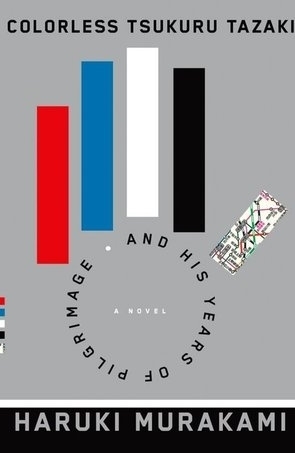You can hide memories, but you can't erase the history that produced them.As Colorless Tsukuru Tazaki and His Years of Pilgrimage begins, the title character has just turned twenty and doesn't care if he lives or dies. When he was in high school, he had been a part of a group of five friends -- compared to an equilateral pentagram or the evolutionary perfection of the five-fingered hand -- a group of two girls and three boys whose interconnectedness transcends most human relationships, and on a trip home from university six months earlier, Tsukuru was informed that none of the other four ever wanted to see or hear from him again; a severance without explanation.
The timeline jumps forward, and at thirty-six, Tsukuru is still feeling the effects of this severance, and at the insistence of his new girlfriend, Sara, decides to revisit his old friends and finally learn the truth of their falling out. What I loved from other Haruki Murakami books is the surrealism of alternate universes that characters find themselves falling in and out of, but in a more realistic twist in this book, Tsukuru's own history is the alternate universe (as L.P. Hartley wrote: The past is a foreign country) and he spends sixteen years on a pilgrimage to return there (but as Thomas Wolfe wrote: You can't go home again).
At the time of his suicidal despair at twenty, Tsukuru went through a total physical transformation (so much so that sixteen years later his old friends couldn’t recognise him), but due to the break with his friends, he was unable to make the mental transformation from adolescent to adult -- and this is the key to this book. At thirty-six, Tsukuru is incapable of forming deep emotional bonds and mopes around like an angsty teenager. If most Murakami feel Jungian, this one is Freudian; complete with unresolved Daddy issues. The following could almost be expected from a sixteen-year-old, but it's rather pathetic from a visibly successful adult man:
I have no sense of self. I have no personality, no brilliant color. I have nothing to offer. That’s always been my problem. I feel like an empty vessel. I have a shape, I guess, as a container, but there’s nothing inside.This is the most straight-forward (I would even say dull) of the Murakami books I've read, but he still snuck in some of his trademark weirdness: I loved Haida's story of the dying piano player and the death token, and I was totally creeped out by the was that real or wasn't it? sex dream. This wouldn't be the best book for a reader to use as an introduction to Murakami, and I have no doubt that I enjoyed it more as a contrast to his other books than as a work on its own, but looking at the current bestsellers list, Murakami is still writing more interesting books than anyone else out there. I would like to give this 3.5 stars, but am rounding down to rank Colorless Tsukuru Tazaki against other Murakami works (and would round up against most any other writer).
One heart is not connected to another through harmony alone. They are, instead, linked deeply through their wounds. Pain linked to pain, fragility to fragility. There is no silence without a cry of grief, no forgiveness without bloodshed, no acceptance without a passage through acute loss. That is what lies at the root of true harmony.*As a bonus, I'm adding the link to the music that figures throughout this book (Franz Liszt's Le mal du pays, as played by Lazar Berman) because it is the perfect musical equivalent of Colorless Tsukuru Tazaki; one could almost listen to the music alone and learn what this book is trying to say: http://youtu.be/FDWUvc5wv7U . As Haida says of the piece's title:
Usually it's translated as "homesickness" or "melancholy". If you put a finer point on it, it's more like "a groundless sadness called forth in a person's heart by a pastoral landscape". It's a hard expression to translate accurately.

